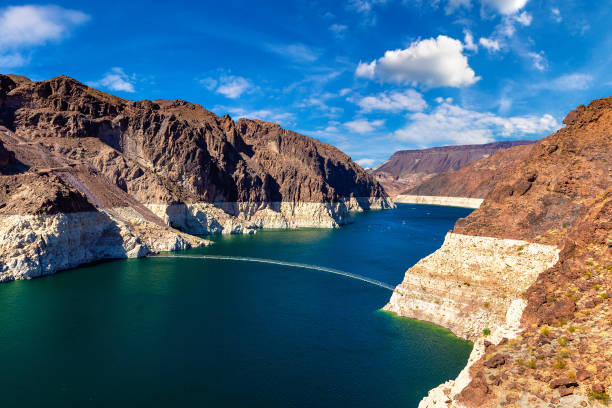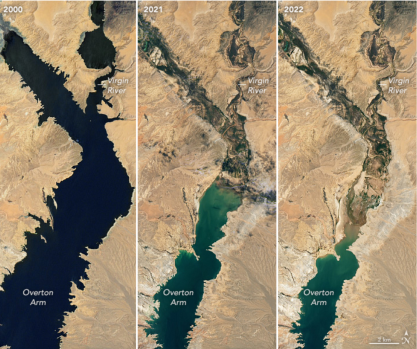Lake Mead

The Slow Death Of Lake Mead
This can’t be ignored anymore!
No disappearing act has ever been slower than the 20-year gradual ebbing of water levels in Lake Mead, Nevada. As people begin handwringing about climate change and receding water in the reservoir—and they should—they are missing what the real problem is with the lake’s slow death.
On June 14, 2022, a Senate committee meeting was held to discuss solutions for Drought in the West. The breadth of the title had little to do with the West, as the meeting singularly focused on the utilization of water within the Upper and Lower Colorado Basin.
Much like all things government, most in attendance missed the point of the crisis. Various Senators chimed in with thoughts and opinions, but none came close to a solution for equitable water distribution from the Colorado. One attendee, Patrick O’Toole, from the Family Farm Alliance, said it best when he remarked that government has been aware of this problem for 20 years and done nothing. Following that simple comment about government inaction, which everyone heard, I couldn't reconcile in my head why the committee then adjourned merely asking for more data and more information. At their fingertips, they have 20 years' worth of information and data.
It’s the management of the whole river system that needs to be rethought. It’s the understanding that each player in the river system will ferociously protect its interest. Past discussions and action have yielded little, and no doubt the blame can be spread all around, but the fact is that Lake Mead is at 27% capacity and Lake Powell is no better. Add to this an observation from writer Joanna Allhands of The Arizona Republic, and it seems that current water restrictions could have been worse, save for some fuzzy math about where thousands of acre-feet of water reside—if it exists at all. It is time for government to take action.
Lake Mead comments from 2022
Las Vegas Valley could be on water rations in as few as 8 years.
First, allow Patrick O’Toole in Wyoming to revive his forest water shed through appropriate environmental administration. He states that he is hampered by government reluctance, which appears to stem from hyper-environmentalism. We will never know if his plan will work unless he employs it. So, allow him to tend to his environment the best way he knows how. He intends to produce annually an additional 144,000 acre-feet of water to the Flaming Gorge Reservoir through smart forestry management.
California needs to practice what it preaches. It needs to be more environmentally responsible when it comes to water and implement water recycling systems that mirror the efficiency of those in Southern Nevada. If we in the desert can do without, so can California. In addition, Colorado can make larger cuts, and Arizona needs to return to Tier 1 cutbacks to lessen the impact on their state.
Third, water distribution can no longer be detailed in acre-feet. It must be calculated as a percentage of the annual volume along the river. Drier years will produce smaller water allotments, requiring everyone to make sacrifices, with the inverse in wetter years producing more water for all. Water levels in reservoirs would be significantly more stable if we were not draining them due to water storage deals between participants.
It’s the management of the whole river system that needs to be rethought. It’s the understanding that each player in the river system will ferociously protect its interest. Past discussions and action have yielded little, and no doubt the blame can be spread all around, but the fact is that Lake Mead is at 27% capacity and Lake Powell is no better. Add to this an observation from writer Joanna Allhands of The Arizona Republic, and it seems that current water restrictions could have been worse, save for some fuzzy math about where thousands of acre-feet of water reside—if it exists at all. It is time for government to take action.
The Bureau of Reclamation acted, and then nothing.
Five days before the 2022 election the Department of the Interior took over the management of the Colorado river. Then they simply ceded the authority back to the offenders. Again, government did nothing.

Quick F.A.Q.
What are Barry’s First Measures?
First, allow Patrick O’Toole in Wyoming to revive his forest water shed through appropriate environmental administration.
Second, build desalination plants in Mexico’s Sea of California. As Huntington Beach, California, declined to take reasonable measures to produce water for its population, we can utilize those dollars to build desalination plants to pipe water to the Mexican towns and farms along the border and also pipe water to California’s Imperial Valley. That water savings from Mexico and California will fill Lake Mead and Lake Powell.
Third, water distribution can no longer be detailed in acre-feet. It must be calculated as a percentage of the annual volume along the river. Drier years will produce smaller water allotments, requiring everyone to make sacrifices, with the inverse in wetter years producing more water for all. Water levels in reservoirs would be significantly more stable if we were not draining them due to water storage deals between participants.
Subscribe to our monthly newsletter and stay up to date with Barry and the campaign!
